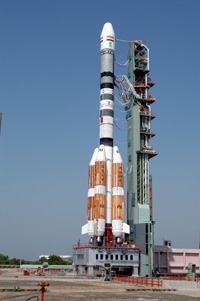India hopes to join cryogenic rocket engine club January 2010
 Chennai, Dec 4 : India's heaviest rocket - the 49-metre tall, 414-tonne Geosynchronous Launch Vehicle (GSLV), powered by the indigenous cryogenic engine, will be launched in January
Chennai, Dec 4 : India's heaviest rocket - the 49-metre tall, 414-tonne Geosynchronous Launch Vehicle (GSLV), powered by the indigenous cryogenic engine, will be launched in January
2010, making it a member of the select club of countries possessing this technology.
Officials of Indian Space Research Organisation (ISRO) say the space agency will start the new year in style, launching the GSLV-D3 carrying the two-tonne communication satellite GSAT-4 sometime next month and not December as hoped earlier.
Speaking to IANS on the condition of anonymity, an ISRO official said: "The launch is expected in January. From the time the satellite reaches the spaceport, one needs at least 30 days' time for checking the systems prior to the launch. The satellite is yet to reach the spaceport."
The GSAT-4 was supposed to reach ISRO's spaceport Sriharikota last month, but is now expected during the middle of this month.
ISRO's director for Publications and Public Relations S. Satish told IANS from Bangalore: "Twenty days' time is sufficient for checking the satellite systems at the spaceport." However, he declined to comment on the probable month of launch.
ISRO's chairman Dr. K. Radhakrishnan was not available for comment on the subject.
GSAT-4 will carry a multi-beam Ka-band bent pipe and regenerative transponder and navigation payload in C, L1 and L5 bands. The satellite can guide civil and military aircraft.
GSAT-4 will also carry a scientific payload, TAUVEX, comprising three ultra violet band telescopes developed by Tel Aviv University and Israel space agency (ELOP) for surveying a large part of the sky in the 1,400-3,200 angstrom wavelengths.
Meanwhile, the ISRO scientists are checking and rechecking the various systems in the cryogenic engine and examining the technical data.
An ISRO official told IANS the test results are being reviewed by experts to be doubly sure about its efficiency so that rocket's third stage can deliver the satellite into geo transfer orbit (GTO) from where it will be taken to an altitude of 36,000 km above earth and then positioned.
The cryogenic engine reached Sriharikota from ISRO's facility in Mahendragiri in Tamil Nadu in October.
ISRO officials told IANS the checks show the cryogenic stage is in a healthy condition and fit for flight.
Only a few countries like the US, Russia, France, Japan and China possess the technical expertise to develop their cryogenic engines and India is expected to join this club.
For all the five earlier GSLV missions, ISRO had used Russian cryogenic engines.
While GSLVs with Russian cryogenic engines have been designated as operational rockets after two developmental flights, the one that will go up in January is called "developmental flight 3"
(GSLV D3) as it will be fired by the ISRO-developed cryogenic engine.
The last GSLV went up on Sep 2, 2007, carrying the 2,130 kg INSAT-4CR satellite.
According to an ISRO official the rocket's two fuel stages - the first stage solid fuel booster and four strap-on motors and the second stage liquid engine has been assembled. The last stage is the cryogenic stage.
In December 2008, the indigenously developed cryogenic upper stage engine passed the flight acceptance test with the engine tested for 200 seconds.
The development of cryogenic engines involves mastering materials technology, operating rotary pumps and turbines which run at 42,000 revolutions per minute (RPM).
The development of a cryogenic engine is crucial for ISRO to build more powerful GSLV rockets that can carry four-tonne satellites.
ISRO is lagging behind in launching its GSAT series due to not having a indigenously-developed cryogenic engine. GSAT was supposed to have gone up two years back.(IANS)